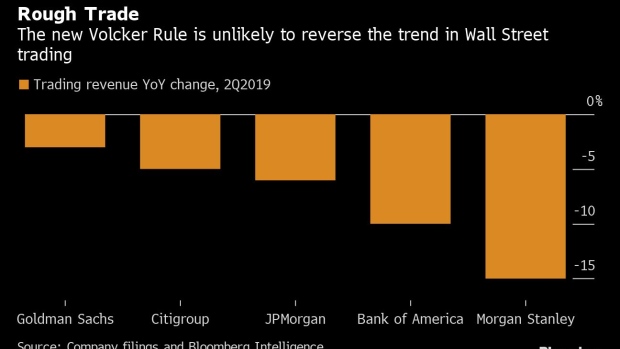Aug 20, 2019
Volcker 2.0 Is Too Little, Too Late for Wall Street’s Traders
, Bloomberg News

(Bloomberg Opinion) -- Five Wall Street regulators have finally released their overhaul to the Volcker Rule after years of complaints from America’s biggest banks. Seemingly, it would be a reason for the industry to cheer.
Instead, it feels like little to get excited about, given that the rewrite comes less than a month after news that Citigroup Inc. was preparing to cut hundreds of jobs in its trading division, a sign that banking executives might be worried about more lasting challenges to the business. Trading revenue at the five biggest U.S. banks dropped 8% in the second quarter and 14% in the first quarter. It’ll take more than tinkering around the edges and simplifying the “proprietary trading” ban to lift bankers’ spirits given the specter of layoffs. To top it off, the inverted U.S. yield curve is poised to further erode the firms’ crucial net interest margins.
So, no, don’t expect bankers to break out the bubbly for Volcker 2.0. As for the details of the overhaul, the range of banned trading won’t change substantially from the original 2013 rule, but the ability to make markets for customers will be made clearer. Bloomberg Intelligence’s Nathan Dean said “the changes won’t likely lead to drastic changes in trading behavior.” While proprietary trading will still be banned, “banks may be able to increase transaction volumes so long as they don't exceed internal-risk limits,” he wrote.
Still, no one is expecting liquidity to return to what it was before the rule took hold. I’ve argued that it’s in the banks’ own best interest to step back during times of market stress, given the potential for steep losses. They don’t have the massive balance sheets they once did for a reason — so that they can’t once again risk the collapse of the financial system.That’s not to say nothing has shifted with this rewrite. Certainly, all signs point to less-burdensome compliance demands. Bloomberg News’s Jesse Hamilton and Benjamin Bain did a great job explaining what was at stake in a preview last week:
In creating the rule named for former Fed Chairman Paul Volcker, who championed the idea, Congress and the regulators banned short-term trades that couldn’t be shown to meet exemptions for things such as hedging or market-making. The rule has assumed that trades are banned unless banks show they aren’t.
The new version is expected to upend that by generally giving banks the benefit of the doubt that they’re in compliance, the people said. Regulators have said they expect to have more confidence that banks are abiding by the rules because the standards will be clearer, allowing firms to plan portfolios with more certainty.
To those with vivid memories of the financial crisis, it’s surely a bit unnerving to see regulators willing to give banks “the benefit of the doubt.” On the other hand, Wall Street has grappled with the initial Volcker Rule for years and presumably has ample evidence that the regulations as written were overly vague and onerous. Federal Reserve Vice Chair for Supervision Randal Quarles has called the revisions “the fruit of long and shared experience.”
Elsewhere, the rewrite is set to loosen restrictions on banks investing their own money in private equity and hedge funds. The regulators may also issue further proposals on the treatment of fund investments. The final changes must be approved by the Fed, the Office of the Comptroller of the Currency, the Federal Deposit Insurance Corp., the Securities and Exchange Commission and the Commodity Futures Trading Commission. Volcker 2.0 also seems likely to face a legal battle.
Some articles referred to the new Volcker Rule as providing Wall Street traders with more “wiggle room,” and that’s probably the right way to think about it. Banking is an intricate industry that needs to be fine-tuned and calibrated based on experience. If Paul Volcker is on board with how his namesake has evolved over the past several years, that should be a sign that this rewrite is by no means a green light for traders to run rampant with speculative bets.
But a bit more leeway most likely won’t be enough to stop the bleeding among Wall Street’s trading desks. It’s not going to reverse the weakness among hedge funds nor stop the pace of technological progress and new products that are crimping spreads across markets. Volcker 2.0 is here, and it doesn’t feel much different.
To contact the author of this story: Brian Chappatta at bchappatta1@bloomberg.net
To contact the editor responsible for this story: Daniel Niemi at dniemi1@bloomberg.net
This column does not necessarily reflect the opinion of the editorial board or Bloomberg LP and its owners.
Brian Chappatta is a Bloomberg Opinion columnist covering debt markets. He previously covered bonds for Bloomberg News. He is also a CFA charterholder.
©2019 Bloomberg L.P.


